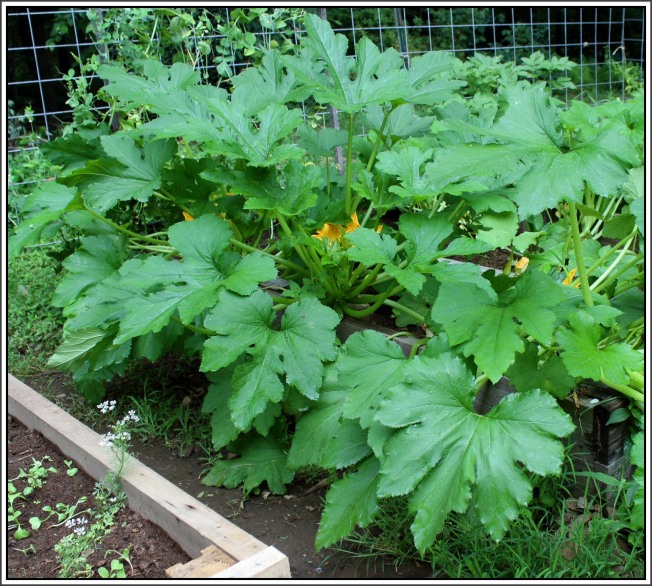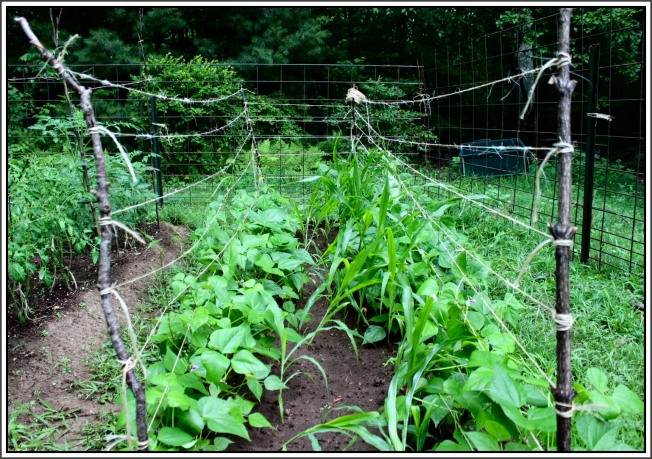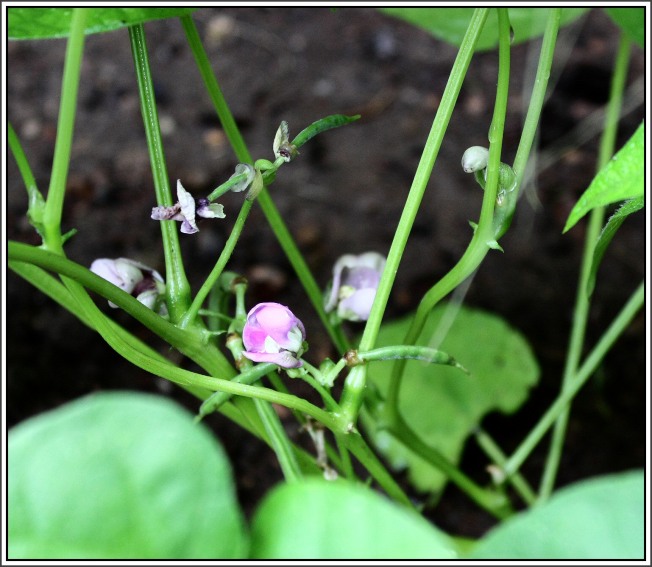I sowed more snow pea seeds a week ago, and all are up. My snow pea plants are slowing production, so I wish I had sown additional seeds sooner. I should have an entirely new crop of snow peas in a couple of weeks. I also sowed some more lettuce seed, but this time in the garlic bed in a couple of spots created by pets digging. Yesterday I found our big, old male cat, Sam, sitting right in the middle of the lettuce seedlings. I chased him away and they seem fine. Silly cat!
My garden plants have grown much larger in the past week but are still not producing much, possibly due to the heat wave — warm is good, 90’s maybe not so much. Now that it is back to normal summer temperatures for Connecticut, I sure hope to see more “fruit” for my labor. As much as I enjoy going to the farmer’s market each week, I sure could use the break on food costs, especially produce which costs more than junk food.
In choosing what varieties to grow this year, much of the choices were based on what I read online on the seed company websites, but it was limited to the descriptions. This week, I discovered that most of the seed companies provide a format for customer reviews. I have been reading a lot of those reviews and wish I had done so over the winter. My favorite site for customer reviews for heirloom seeds is Baker Creek Heirloom Seeds, the company that owns Comstock, Ferre & Co. here in Connecticut.
For example, I planted Cocozelle Di Napoli green summer squash, a zucchini type of squash. What I read, and what I have discovered myself is that this particular variety grows huge, much larger than most other varieties of zucchini. I also read that it is not on the prolific side. Now, in a few weeks this might be a welcome fact as most of the time zucchini plants produce so much that gardeners are pulling their hair out to eat it all, share it or preserve it. I seem to have the opposite situation, though, with only 3 fruits growing at present. One benefit to the Cocozelle Di Napoli squash is that it produces copious amounts of male flowers. If you want to sell squash blossoms, or enjoy batter-fried squash blossoms this might be the squash plant for you.
My yellow squash plants are producing a lot of baby squash and I am hoping that they are pollinated and grow to maturity, albeit small because squash should be harvested when small and tender, when the seeds are not developed. Additionally, should you be shopping for squash at a farmer’s market or grocery store, always choose the smallest squash. The same goes for cucumbers: smaller is better unless it is a hothouse or Asian cucumber.
Pumpkins are zero for pollinated, growing pumpkins so far. The vines are taking over the garden and back yard, but so far no pumpkins. The one that I had hope for apparently wasn’t pollinated. I will be hand pollinating female flowers in the future, leaving nothing to chance. My 20 year old son pointed out that all of the bees seem to be distracted by the milkweed patch and not visiting the rest of the garden much.
UPDATE: I dropped by my town’s garden center today and spoke to one of their experts, explaining about my pumpkin and squash problems. She recommended Espoma Epsom Plus (which appears to have been discontinued), which contains magnesium, sulphur and potash, to increase the nutrients in the soil that encourage fruit development, and to be sure to water my pumpkin plants every day and deeply. She believes my problem with baby pumpkins dying before the flowers even open up is due to low water stress. The soil felt moist to my fingers when I checked it, but I wasn’t watering every day, and in a raised bed, plants need a lot more water. I will side dress my squash and pumpkin plants with this new fertilizer and make sure to water my pumpkins every day. Fingers crossed that I see results quickly.
My cucumbers are getting a lot of attention from small bees, though. I have many cucumbers growing on those vines, and they are beginning to cover the bean teepee. The pickling cucumbers will not take long to mature, but the Suyo Long cucumbers take much longer as they grow from 14″-18″. I harvest at around 14″ because I usually can’t wait any longer.
No flowers on the peppers and eggplants yet. Aunt Molly’s ground cherry plants are covered in little green paper lanterns. I have lots and lots of tomatoes this year, thank goodness! After moving the broccoli plants from the terraced bed, the tomato plants in the same bed began to set fruit. I had read that broccoli plants should never be planted close to tomato plants and after reading and asking questions on some forums received a couple of answers: 1) broccoli can carry a virus that does not affect them but does affect tomato plants, and 2) broccoli plants somehow interfere with setting fruit on tomato plants. I guess the latter is definitely true, though scientifically I could find no reason for this.
Tomato plants in grow bags in the back yard garden that receives less sunlight and is much cooler are not producing nearly as many tomatoes as the tomato plants in grow bags beside the driveway. I wish I had planted some pepper plants in grow bags in the same driveway area for extra heat (I wanted to do this but just didn’t want to haul any more soil). I did move three pepper plants and one eggplant to the new raised bed as that particular bed gets the most sun out of the back yard raised beds.
The black bean plants already have bean pods and lots of flowers for more. I have a confession: I grew these from beans I bought in my food co-op, Eden brand organic black beans, after researching and reading and finding only one black bean seed variety available online. I figured that I would end up with the same black beans I would get if I bought seeds. I bought two packets of Cherokee Tears black beans from Comstock, Ferre & Co. anyways when I was there a couple of weeks ago. I haven’t planted them, and won’t this year. Next year, though, I will give them a try to see if there is any difference between the varieties.
No helpful rain in over 9 days. It did rain a few days ago, but it just wet the surface of the soil. It was a little bit frustrating watering my entire garden after a rain. We need a soaking rain, but I don’t want it to rain in the evening. This will contribute to powdery mildew on the squash and pumpkin leaves which will stop production and kill the plants. So I water half of the garden one day and the other half the next day with the tomatoes in grow bags by the driveway getting water every day.

I transplanted three pickling cucumber plants from the bean teepee garden area; 2 survived and are growing up the structure I built for the tomato plants in the front garden
I hope your garden is doing well. Happy gardening!













Thanks for the all the tips–we are down here in Westchester (not that far, climate-wise) so most of what you’re talking about relates to our neck of the woods as well. Our pumpkins really struggle in the dog days of summer, too. Heat and humidity can take a toll. Fingers crossed you avoid the powdery mildew experience as well. You can muscle through it but the vines look really nasty by the end. 😦 Good luck with all the delicious veggies!!!
LikeLike
Powdery mildew did in all of my pumpkin and squash plants last year, so I have been reading, researching and asking local gardeners what they do. One person recommended 2 tsp of baking soda to a gallon of water before any powdery mildew appears (I asked if I could start spraying before I see it), and then when I see it 1-2 tsp baking soda to a quart of water. She mentioned spraying with copper sulphate, but I don’t believe that is considered organic and can be toxic to humans and pets. After doing some more reading it looks like baking soda and water plus a dormant oil and a little insecticidal soap is the best option for preventing and treating powdery mildew. I hope we have a break from powdery mildew this year, and keeping my fingers crossed about squash vine borers.
LikeLike
Fingers crossed down here, too!
LikeLike
Too funny on the Napoli squash part – that it gets huge, and not prolific and many male flowers. I’m seeing the same, so was trying to understand if this is normal. I was trying to do a 3 sisters setup, so maybe Napoli wasn’t the best option for that?
Here’s mine, and while that’s two squash plants up front, the one in front is mostly covering up the one on the other side – http://www.gthomson.us/projects/landscaping/corn-squash-juneend.jpg
LikeLike
I have had the best luck with growing Black Beauty zucchini squash. Napoli was a disappointment all around for me.
LikeLike
Well, after pruning my Napoli squash that weekend, they really took off on the fruiting side. Here’s my latest just found it on the back side today – it’s next to a store-bought zuchinni – http://www.gthomson.us/projects/landscaping/new-squash-2.jpg.
I know in your post you said make sure to buy the squash small.
But each one I pick is about an inch or two bigger than the previous, and so far this is the biggest (about 15″), and still tasting good. Seeds are barely noticeable inside, so I’m guessing that means it could even get a bit bigger and still be okay?
Now I’m scrambling to find some good squash soup recipes that freeze well.
I’ve got about 10-12 more still on the plant that are about 5-6″ in size. So they’ll be pretty big in another week.
I like squash, but it’s getting a little overwhelming now how much I’m getting from it.
It’s been really hot here the past couple weeks – just under 100 degrees – so they must really love the hot weather.
I also saw you mentioned not to buy big cucumbers, except for a couple types.
You might also want to add Armenian cucumbers to that list. I’ve only gotten one so far, but it was 18″, and only about 1″ in diameter. But was still good at that size. And I never even used to like cucumbers, until I started growing my own.
LikeLike
I never would have even thought to prune a squash plant. Apparently, that seemed to force the plant into fruiting. I like that the squash do not ripen until they must get very large, meaning you can let them grow larger than you would the Black Beauty variety. Congratulations on being overwhelmed with squash.
For larger squash, I like to make stuffed squash using sausage, cottage/ricotta cheese, herbs, maybe a grating of mozzarella on top. The recipe I use is in The Victory Garden Cookbook by Marian Morash.
Cucumbers: the Asian cucumbers are picked long. Traditional slicing and pickling cucumbers are picked younger so that the skins are not tough and seeds are not developed. I like to grow all three types. The Asian cucumbers easily get to 18″ without mature seeds.
Sounds like you are having a great gardening season. Enjoy!
LikeLike